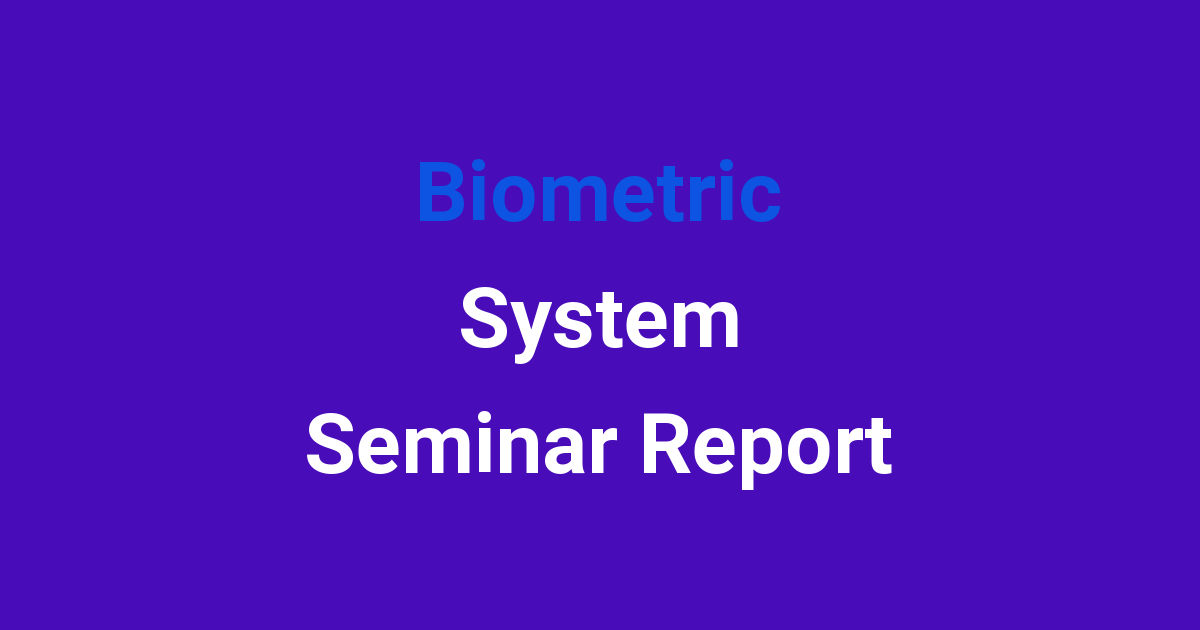Seminar report on biometric authentication system.
Biometric System Seminar Report
Introduction:
Biometric authentication is an essential aspect of security in today’s digital age. It involves the measurement and analysis of unique physical or behavioral characteristics of an individual to verify their identity. Biometric systems have gained popularity due to their convenience and accuracy in verifying identities. This seminar report will highlight the importance of biometric systems, analyze the existing systems, discuss their disadvantages, propose a new system, and highlight the advantages and features of the proposed system.
Problem Statement:
The existing biometric systems have limitations in terms of accuracy, speed, and security. Some systems are prone to errors and can be easily hacked or manipulated. Additionally, the high cost of implementing biometric systems is a barrier for many organizations. Therefore, there is a need to develop a more efficient and secure biometric system that overcomes these limitations.
Existing System:
The existing biometric systems commonly used include fingerprint recognition, iris recognition, facial recognition, voice recognition, and palm vein recognition. These systems have been implemented in various sectors such as banking, healthcare, government, and law enforcement. While these systems are effective in verifying identities, they have limitations such as susceptibility to spoofing attacks, high false acceptance rates, and slow verification speed.
Disadvantages:
1. Vulnerability to spoofing attacks: Some biometric systems can be easily fooled using fake fingerprints or facial masks.
2. High false acceptance rates: False acceptance occurs when the system incorrectly identifies an unauthorized individual as an authorized user.
3. Slow verification speed: Some biometric systems take a long time to verify identities, leading to delays in access control.
Proposed System:
The proposed biometric system will use a combination of multiple biometric modalities for enhanced security and accuracy. The system will incorporate fingerprint, iris, facial, voice, and palm vein recognition technologies to create a multi-modal biometric system. This approach will increase the complexity of the system, making it more secure and resilient to spoofing attacks.
Advantages:
1. Enhanced security: The multi-modal biometric system provides an additional layer of security by combining multiple biometric modalities.
2. Improved accuracy: By using multiple biometric modalities, the system can achieve higher accuracy in verifying identities.
3. Faster verification speed: The use of multiple biometric modalities allows for quicker verification, improving efficiency in access control.
Features:
1. Fingerprint recognition: This biometric modality involves scanning an individual’s fingerprint to verify their identity.
2. Iris recognition: Iris recognition is a biometric modality that identifies individuals based on the unique patterns in their iris.
3. Facial recognition: Facial recognition technology analyzes the unique features of an individual’s face to verify their identity.
4. Voice recognition: Voice recognition technology identifies individuals based on the unique characteristics of their voice.
5. Palm vein recognition: Palm vein recognition scans the veins in an individual’s palm to verify their identity.
Conclusion:
In conclusion, the proposed multi-modal biometric system offers an innovative and secure solution for verifying identities. By combining multiple biometric modalities, the system enhances security, accuracy, and efficiency in access control. The system addresses the limitations of the existing biometric systems and provides a more robust solution for organizations looking to strengthen their security measures. Further research and development are needed to prototype and implement the proposed system in real-world scenarios.

